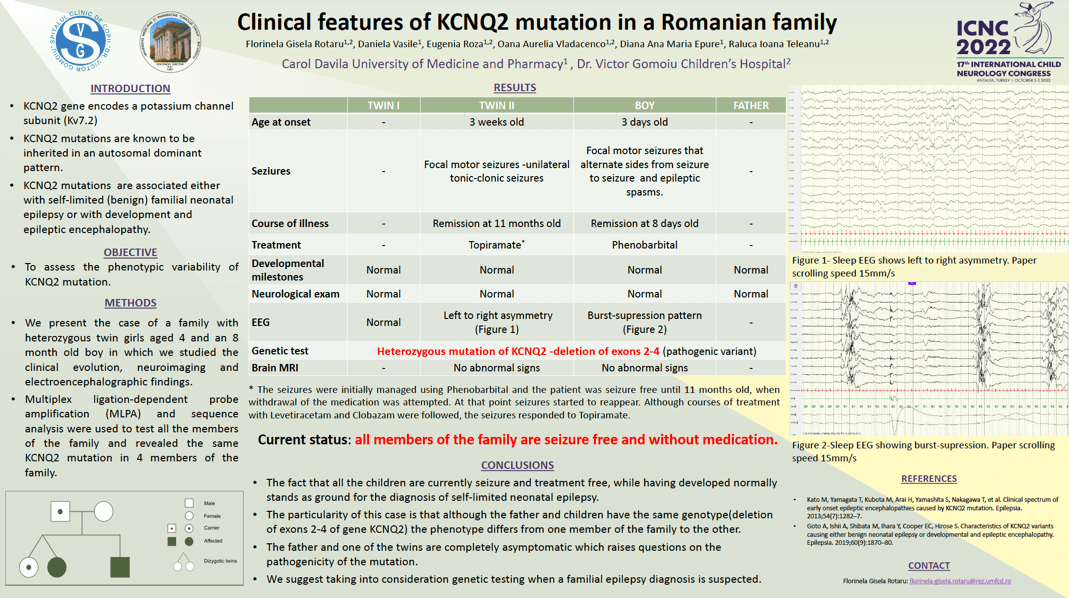Clinical features of KCNQ2 mutation in a Romanian family
Florinela Gisela Rotaru, Daniela Dorina Vasile, Raluca Ioana Teleanu
Objective: KCNQ2 mutations are known to be inherited in an autosomal dominant pattern and are associated either with self-limited (benign) familial neonatal epilepsy or with development and epileptic encephalopathy. Our purpose is to assess the phenotypic variability of KCNQ2 mutation. Methods: We present the case of a family with a pair of heterozygous twin girls, 4 years of age, and an 8 months old boy in which we study the clinical evolution, neuroimaging and electroencephalographic findings. Multiplex ligation-dependent probe amplification (MLPA) and sequence analysis was used to test all the members of the family. Results: At approximately 3 weeks old, one of the girls presented focal seizures. She followed different therapeutic schemes but the seizures responded to Topiramate. Her younger brother, started having seizures at 3 days of age which were contained with the use of Phenobarbital. The sequence analysis and MLPA identified in the father and all the children, the heterozygous mutation of KCNQ2 consisting in the deletion of exons 2-4 – a pathogenic variant. Conclusions: The particularity of this case is that though the father and the children have the exact same mutation (deletion of exons 2-4 of gene KCNQ2) the clinical features differ from one member of the family to the other. When seizures affect more than one family member, genetic testing should always be taken into consideration.
Keywords: KCNQ2, autosomal dominant, phenotypic variability, deletion exons 2-4, pathogenic variant
Florinela Gisela Rotaru
Carol Davila University of Medicine and Pharmacy, Bucharest, Romania
Romania
Daniela Dorina Vasile
Children's Hospital Doctor Victor Gomoiu
Romania
Raluca Ioana Teleanu
Carol Davila University of Medicine and Pharmacy, Children's Hospital Doctor Victor Gomoiu
Romania
Objective: KCNQ2 mutations are known to be inherited in an autosomal dominant pattern and are associated either with self-limited (benign) familial neonatal epilepsy or with development and epileptic encephalopathy. Our purpose is to assess the phenotypic variability of KCNQ2 mutation. Methods: We present the case of a family with a pair of heterozygous twin girls, 4 years of age, and an 8 months old boy in which we study the clinical evolution, neuroimaging and electroencephalographic findings. Multiplex ligation-dependent probe amplification (MLPA) and sequence analysis was used to test all the members of the family. Results: At approximately 3 weeks old, one of the girls presented focal seizures. She followed different therapeutic schemes but the seizures responded to Topiramate. Her younger brother, started having seizures at 3 days of age which were contained with the use of Phenobarbital. The sequence analysis and MLPA identified in the father and all the children, the heterozygous mutation of KCNQ2 consisting in the deletion of exons 2-4 – a pathogenic variant. Conclusions: The particularity of this case is that though the father and the children have the exact same mutation (deletion of exons 2-4 of gene KCNQ2) the clinical features differ from one member of the family to the other. When seizures affect more than one family member, genetic testing should always be taken into consideration.
Keywords: KCNQ2, autosomal dominant, phenotypic variability, deletion exons 2-4, pathogenic variant
Florinela Gisela Rotaru
Carol Davila University of Medicine and Pharmacy, Bucharest, Romania
Romania
Daniela Dorina Vasile
Children's Hospital Doctor Victor Gomoiu
Romania
Raluca Ioana Teleanu
Carol Davila University of Medicine and Pharmacy, Children's Hospital Doctor Victor Gomoiu
Romania

Florinela Gisela Rotaru
Carol Davila University of Medicine and Pharmacy, Bucharest, Romania Romania
Carol Davila University of Medicine and Pharmacy, Bucharest, Romania Romania